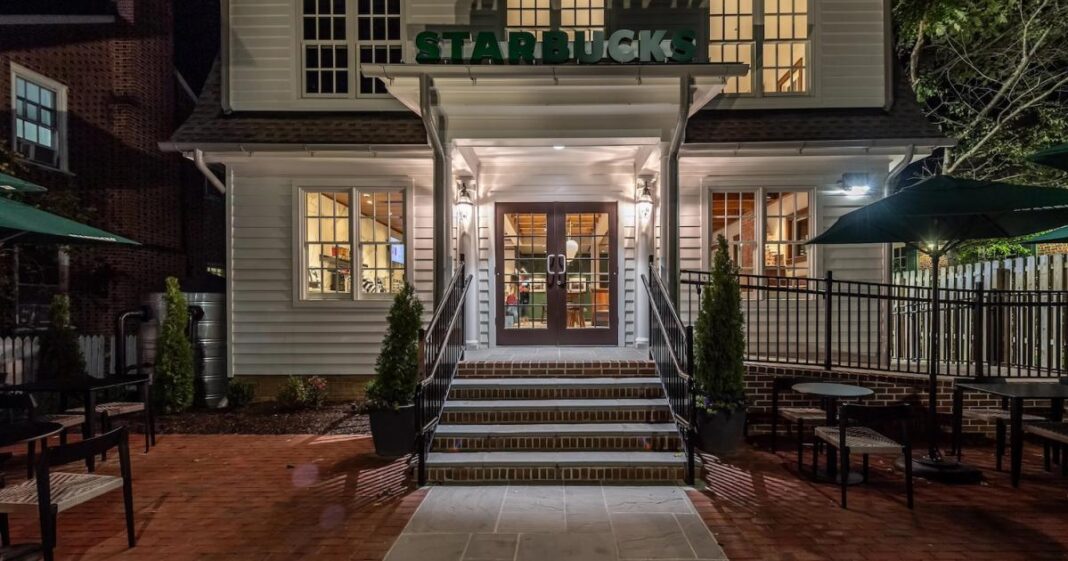As of March, Starbucks classified almost 16 percent of its 38,587 cafes as “Greener Stores,” locations that meet rigorous requirements for waste, energy and water savings.
That’s almost double the number it reported in April 2023, and more than halfway to 10,000, the number Starbucks wants to certify worldwide by the end of 2025. The vast majority of those locations (5,488) are in North America. Starbucks has about 38,600 cafes globally.
In Latin America and the Caribbean, all new stores are built to Greener Stores specifications, and the company’s real estate team is considering which markets should be next.
In the U.S., Greener Stores practices have reduced energy and water consumption by 30 percent and saved almost $60 million in annual operating costs. Starbucks’ larger corporate commitment is to reduce emissions, water usage and landfill waste by 50 percent by 2030.
The vision is that all new stores should be built to Greener Stores specifications and that existing locations be retrofitted as updates are needed, said Michael Kobori, chief sustainability officer at Starbucks. “At this point, it really depends on the economics in different regions,” he said. “What I would say is that, generally, in North America, the economics work for new stores, to build them as greener stores.”
Inspired by the LEED certification program
Starbucks launched the Greener Stores framework in September 2018. Co-developed with World Wildlife Fund, it builds on Starbucks’ investment in the Leadership in Energy and Environmental Design (LEED) certification from the U.S. Green Building Council, which recognizes low-carbon construction processes and design. (Starbucks helped the council create the LEED for Retail designation.) The key difference between the LEED program and Greener frameworks is a focus on operational metrics.
“Then we have to make sure that the way the store is operated, and how our partners are trained, also matches,” Kobori said.
The company trains employees through the Starbucks Global Academy. One goal is to get uncertified Starbucks locations thinking about changes to suppliers, services or site design that could bring a store into compliance, Kobori said.
Starbucks’ construction requirements
To become a Greener Store, locations must pass an independent audit by SCS Global Services verifying investments and practices across eight environmental impact areas. The requirements include:
- Renewable energy, from wind, solar or other clean electricity sources or on-site facilities such as solar panels.
- Energy efficiency, including LED lighting, high-efficiency dishwashers and ventilation systems, as well as refrigerators that use low global-warming-potential coolants.
- Water reduction technologies and practices.
- Health and wellness measures for Starbucks employees and customers, such as air-quality systems, noise-level reduction or regulation of store temperatures.
- Responsible materials selection, such as mercury-free lighting, as well as reuse strategies.
- Waste diversion for packaging and unsold food, including reusable cups and totes or the Starbucks FoodShare program.
- Community service efforts.
- On-site electric vehicle charging or green roofs.
The Starbucks location in Williamsburg, Virginia, is one of six sites recognized earlier in March as Greener Stores of the Year. The building was a 100-year-old home before it was retrofitted as a cafe with these features:
- Renewable electricity sourced from the local grid.
- An on-site rainwater collection system for landscape irrigation.
- Banquettes made from recycled wood

Offering the Greener Stores blueprint to everyone else
Standard templates such as Greener Stores are increasingly common among restaurant chains, especially those whose shareholders are scrutinizing their sustainability programs, said Alastair MacGregor, national business line executive and green buildings analyst with consulting firm WSP.
Many prioritize passive architectural design measures that reduce energy consumption, such as maximizing the use of natural lighting in seating areas and choosing food prep and ventilation equipment so it’s the right size for each individual location. “You’ve got to read the room a bit,” he said.
But smaller retail organizations often find it difficult to justify the upfront costs of installing technologies that aren’t yet mainstream, said Jeff Clark, director of business engagement on food safety, nutrition and sustainability at the National Restaurant Association.
“For corporations that have accountants and analysts and people who can crunch the numbers and figure the payback … these investments make sense,” he said.
Starbucks’ Global Academy course is also free to suppliers who want to stay abreast of the company’s procurement requirements and other retailers seeking to reduce the environmental impact of their real estate.
“We would love to see other retailers take a look at the standard and start using it,” said Kobori.
